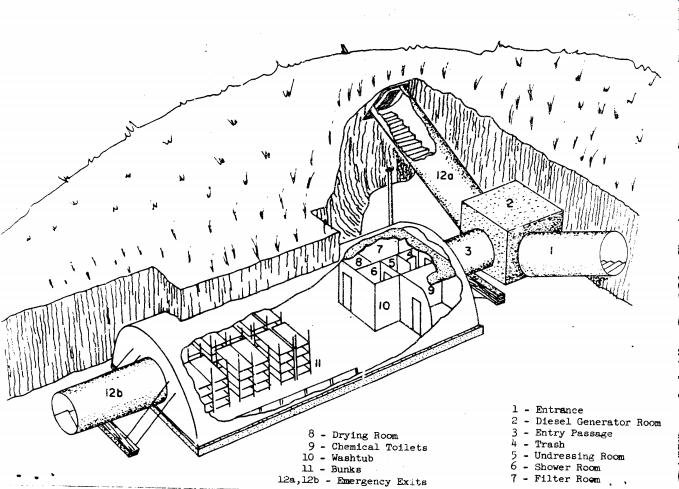This diagram shows a prototype blast and fallout shelter constructed in 1961 at the National Naval Medical Center, now known as Walter Reed National Military Medical Center, in Bethesda, Maryland. It was used in various occupancy studies in which test subjects were housed in the shelter for various lengths of time. However, all of those studies were flawed in one respect: In a real attack, people need to go to the shelter with little if any advance notice or preparation. This condition is very hard to duplicate in a research experiment. It’s necessary to tell people in advance about the experiment in order to get their consent. So in 1963, the Navy came up with a test that would duplicate, as much as possible, the surprise factor inherent in a real emergency situation.
To conduct the test, the Navy recruited Naval Reserve Officers to participate in a seminar, ostensibly to last two weeks, involving lectures and field trips. They were told to bring work clothing, and because there would be extensive field trips, they were told not to bring their families or make plans for social engagements. The seminar would satisfy their two-week training obligation.
34 Officers volunteered, and attended a lecture the first morning. After lunch, they went on their first “field trip,” to the shelter shown here. After a tour, the seminar organizers made a presentation on the necessity of a realistic simulation of emergency occupancy. With no further ado, the group was requested to volunteer to remain in the shelter for an indefinite period. There was “no question that the participants were taken completely by surprise whn they were requested to remain in the shelter. Their faces betrayed a moment of disbelief followed immediately by the cooperative acceptance of an unexpected situation for which Naval officers are trained.”
The officers were informed that continued participation was completely voluntary. Only one officer departed at that time, since he was a University professor who was obligated to write some final examination questions. However, after he wrote his questions and mailed them to his school, he returned to the shelter the same day as a “casualty.”
The participants spent the next several days susbsisting on rations, taking simulated radiation measurements to estimate their departure time, and generally performing the tasks necessary for shelter occupancy. Because most of the officers had an engineering background, they were also tasked with making recommendations for improvements to the shelter.
The report of the experiment is available at the Defense Technical Information Center and contains numerous recommendations from the participants.
The participants’ reactions to the experiment were in four categories, of approximately equal numbers. One group viewed the experience as an interesting challenge and opportunity. Another group reacted with immediate and surprised anger at being “exploited,” even though they were still willing to volunteer. A few bordered on belligerence. Another group was initially unhappy and eventually either withdrew or became minimally cooperative. The natural leaders of the group emerged from those who viewed the experiment as a challenge, as well as among those who initially felt “exploited.”
Rations consisted mostly of survival biscuits, supplemented with tomato soup, peanut butter, and jelly. Coffee was provided, along with sugar and coffee creamer. The average calorie consumption was 1414 calories per day and the men experienced an average weight loss of 1.1 kg.
After 4-1/2 days, the simulated radiation levels had dropped to safe levels, and the confinement in the shelter ended.
Click Here For Today’s Ripley’s Believe It Or Not Cartoon
![]()


Pingback: Fallout Shelter Occupancy Experiment, 1964 | OneTubeRadio.com